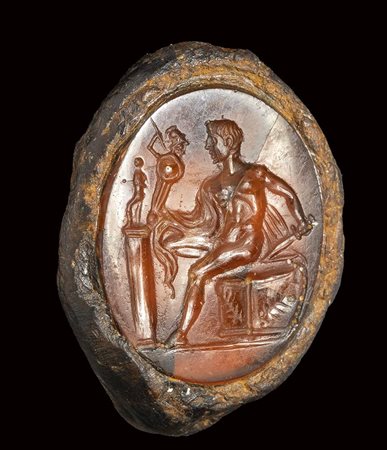 Bertolami Fine Art - Bertolami Fine Art, 1 Harewood Place 1, W1S 1BU Londra
Bertolami Fine Art - Bertolami Fine Art, 1 Harewood Place 1, W1S 1BU Londra
ASTA 107 - Glittica Sessione Unica
venerdì 22 aprile 2022 ore 15:00 (UTC +00:00)
A fine roman carnelian intaglio set in a fragmentary iron ring. Diomedes with Palladium.<br><br>1st century B.C.
A fine roman carnelian intaglio set in a fragmentary iron ring. Diomedes with Palladium.
1st century B.C.
The hero is seated on an altar decorated with garlands, facing left. The head is in profile, the torso of three quarters; the right leg is raised with the knee bent and resting on the base, the left leg is stretched and rests on the ground, on the groundline. Diomedes is naked covered on his arm only by a cloak. With his right hand he holds the Palladium, with his left a sword. In front of him, a column with an idol. The scene depicts the famous mythical episode of the Trojan War. The intaglio is executed with great skill and refinement in the anatomical details. Use of globular elements. The gem is still mounted and firmly fixed in its iron ring (fragmentary, without the rod), and is broken inside the setting (probably due to the swelling of the iron over time). Late republican style with greek influences. Parallels: Jean-marc Moret, Les pierres gravées antiques représentant le rapt du Palladion, n. 15(Chatsworth), 19 (La Haye), 103, 116, 180 ss (Cambridge, Hermitage etc.)., 219 (Genève), 221 (British Museum), 225 (Duke of Chatsworth) signed Gnaios, 226 (Chatsworth, Duke of Devonshire), signed Dioskourides, 270 (Coll. Sangiorgi).
Stone 14 x 17 mm; moumnting 16 x 22 mm.
Provenance: UK private collection.





